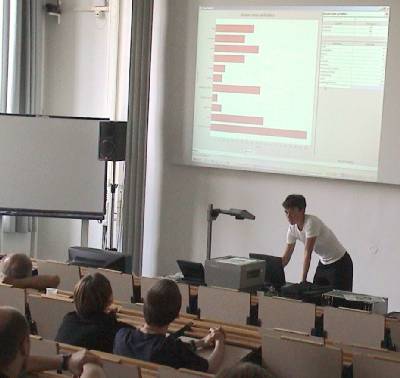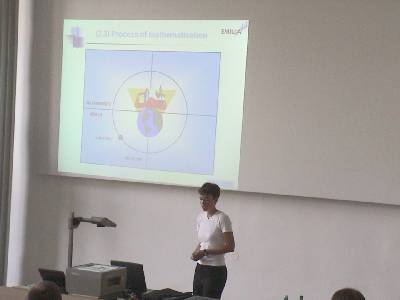Abstract.
The student course of the e-stat project uses multimedia support in order to develop an interactive internet-based learning and teaching environment. This unique educational environment opens a wide horizon of new perspectives and various didactic possibilities in approaching statistical problems and finding their solutions.
1 General reasons for a school and teacher-course in e-stat
Statistics is regarded to be an important aspect of mathematics education (NCTM, 2000). Thus, general school guidelines in Germany were analysed concerning the question which role statistical education plays in the German education system. In the course of this analysis it was found that the various states in Germany have their main focus on different content areas in the field of statistics. However, states do not only differ in their approach to the content of statistics, but also in the intensity that attention is paid to the issue of statistics.
Statistics plays mostly a minor role in the school curriculum. However, students are expected during their whole lives to apply statistical knowledge. This presents a severe contradiction between teaching goals and expectations of the students. Very often students are confronted with issues about statistics in their daily lives, further professional education or subsequently in their final professions.
If students are not sufficiently educated in statistics in school, they are not able to accomplish certain statistical challenges and therefore are facing disadvantages in pursuing their careers.
At this point the development of the e-stat project comes in: The multimedia, internet-based and active teaching and learning environment of the e-stat project offers a new range of various perspectives on the subject matter of statistics in secondary schools.
2 Didactic impulses which are essential to the development of the course
The students´ course in the e-stat project offers a special teaching and learning environment. This unique situation entails different possibilities of taking into account a range of various didactic aspects.
The subject matter of the e-stat project makes use of authentic material, such as data from daily life environments. The different learner interests are taken into consideration, and they play a crucial role in the course development.
We will provide an environment which gives students the opportunity to solve statistical problems in an interactive process. This interactive process is characterized by student-directed actions.
By engaging in this multimedia project the students´ cognitive and non-cognitive abilities will be challenged in the course of the same process.
3 Practical ways of including the didactic aspects mentioned above into the project - some examples
In order to integrate the didactical criteria into the developing process of e-stat the students´ learning should take place by addressing different motivations within the student. This aspect plays an essential role and should be, for example, put into practice by using video-simulation and different forms of visualization and verbalization.
Moreover, students will be able to examine in a playful way their personal level of achieved knowledge. This is made possible for the learner by fill-in-the-blank texts and multiple choice tests. Students will be offered the opportunity of participating in collecting data and should develop a substantial data competence by taking a critical look at various statistical problems.
The e-stat student course will be implemented as a learning environment which provides challenging non-routine problems and supports active, self-initiated learning processes as it is suggested by recent research results in mathematics education (Baumert, Lehmann u.a., 1997; Reiss, Klieme und Heinze, 2001).
References
Baumert, J., Lehmann, R. u.a. (1997). TIMSS - Mathematisch-naturwissenschaftlicher Unterricht im internationalen Vergleich: Deskriptive Befunde. Opladen: Leske + Budrich.
Borovcnik, M., Engel, J., Wickmann, D. (2001). Anregungen zum Stochastikunterricht: - Die NCTM-Standards 2000 - Klassische und Bayessche Sichtweise im Vergleich. Hildesheim: Franzbecker-Verlag.
National Council of Teachers of Mathematics (NCTM) (2000). Principles and Standards for School Mathematics. United States of America.
Reiss, K., Klieme, E. und Heinze, A. (2001). Prerequisites for the understanding of proofs in the geometry classroom. In: M. van den Heuvel-Panhuizen (Ed.), Proceedings of the 25th Conference of the International Group for the Psychology of Mathematics Education. Vol. 4, Utrecht (The Netherlands): Utrecht University.
Keywords:
Statistical education, web-based learning, didactic aspects, special teaching environment, active learning

